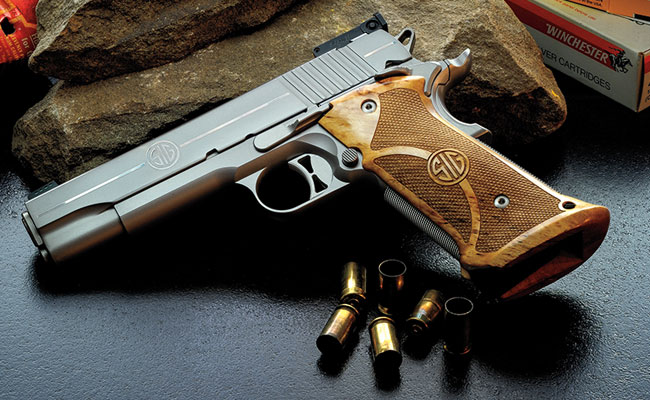
SIG Sauer 1911 Super Target
Precision shooters have never had it so good. Whether you are into Bullseye or other competitive sports, picking a handgun to do the job is easier than ever. In the past, you had to purchase a gun, pick a good gunsmith and have him tune it for you. Today, manufacturers like SIG take all the drudgery out of tricking out a handgun for competition. Take, for example, its Model 1911 Super Target pistol. Right off the shelf this gun is ready for the range and your favorite sport. Caliber is .45 ACP with all the standard features that a good competitive gun would have.
First, I have to say this is one very handsome handgun. Made from stainless steel, the finish on the gun is a high gloss, satin finish, if that is possible. To accent the gun, there is a racing stripe along the slide with the SIG logo in a polished stainless. The components share the same finish, which adds to the gun’s classic looks.
The top of the slide is rounded off and has a serrated strip along the top that starts at the rear sight and ends just before the front sight blade. There are traditional cocking serrations at the rear. Slide-to-frame fit was wiggle free, and no tool marks were evident.

The top of the slide is serrated for a no-glare sight picture, and the fiber-optic front sight features an open top and holes on the side to get the maximum amount of light on the rod.
The rear sight assembly is the typical sight we’ve come to expect from SIG. It is adjustable for both windage and elevation, although there’s no clue as to what the specifications are for sight movement per click.
The rear sight is serrated to help reduce glare, and it sports a well-defined notch and rounded corners. The front sight boasts a pea green fiber-optic insert. Carefully engineered, the blade has small holes drilled in the sides to allow the light to enter the sight, giving it extra luminescence against a dark or black center bull.
The extractor is long and reliable, as is the mechanical ejector deep within the confines of the frame. The ejection port is extended, rounded off and concave at the rear to help clear the spent rounds while at the same time keeping them free of dings for all you reloaders.
The match-grade barrel is a full five inches and topped off with a slight bump at the end for a tight fit within the confines of the barrel bushing.
The trigger has been skeletonized to a reasonable degree and has an overtravel adjustment, but I was slightly disappointed by the five-pound pull.
The hammer has been partially skeletonized as well (about half of its mass), and the only criticism I have here is SIG could have made this a little wider at the top, sort of target width. My

